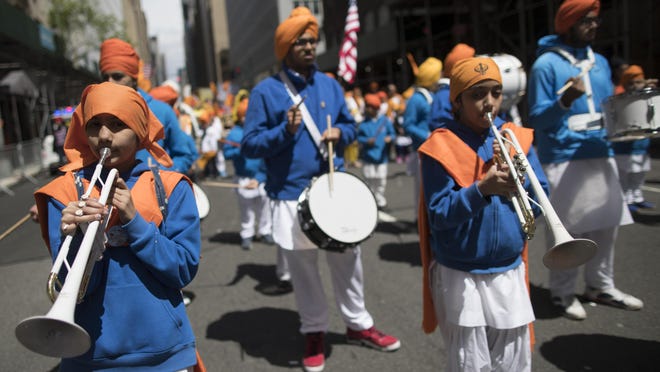Officials at a North Carolina university are being criticized after an incident in which a Sikh student was detained for wearing a kirpan, a curved dagger carried by some Sikhs as part of their faith.
The incident took place Thursday in a student union building at the University of North Carolina at Charlotte. A 44-second video of the incident was posted Friday afternoon on Twitter, where it has since been viewed more than 3.5 million times.
Kirpans are one of five symbolic articles central to the expression of faith for baptized Sikhs and are often blunt and sewn into the sheath.
“It’s really unfortunate that we’re here in 2022 and still having these issues,” said Kiran Kaur Gill, executive director of the Sikh American Legal Defense and Education Fund, known as SALDEF. “It’s a way of practicing and showing faith. A lot of times you can’t even remove them from the sheath.”
About 500,000 Sikh Americans live in the U.S., according to the Sikh Coalition, a community advocacy agency based in New York City.
The U.S. Sikh community has been a target of hate crimes, and in April 2021, four Sikhs were killed as part of a mass shooting that claimed eight lives at a FedEx facility in Indianapolis, Indiana.
In the video, posted to Twitter, the unnamed student, wearing a turban, sits across from another student in a communal area of the university’s student center, with the sheathed kirpan slung around his shoulder.
“You can’t have this,” an officer says as he seemingly attempts to pull the kirpan out.
“OK, but you can’t take it off me,” the student replies, arms raised. “You want me to take the whole thing off?”
When the officer does not respond, he repeats the question. Instead, the officer yanks the student up by one arm and says, “Stand up for a second.”
The student complies, stepping over his backpack while saying, “What are you doing to me, bro?”
The officer pulls the student’s arms behind his back, cuffing him. “OK, so right now you’re just being detained,” the officer tells him.
In his Twitter post, the student said he didn’t plan to post the video but didn’t think he would receive any support from university officials.
“I was told someone called 911 and reported me, and I got cuffed for ‘resisting’ because I refused to let the officer take my kirpan out,” he wrote.
Many lashed out on the social media platform, with some noting that John Bogdan, the university’s associate vice chancellor for safety and security, was once a former commander at the U.S. detention center in Guantanamo Bay. Others posted a fact sheet about Sikhs compiled by the Sikh Coalition.
Another wrote: “I must admit I was unaware of kirpan, the significance, or that it has legal exemptions. But then again, I am not a campus police officer on a multicultural campus. Seems like the people we pay to enforce laws, should be well educated in our laws.”
The university issued a statement Friday from University Chancellor Sharon Gaber and Chief Diversity Officer Brandon Wolfe apologizing for the incident, explaining that university police dispatch had received a 911 report of someone with a knife in the building.
“Police officers responded to the scene and engaged the individual in question,” the statement read. “During this interaction, the individual was placed in handcuffs while officers took possession of the object.”
Police eventually determined that the knife was in fact a kirpan, one of five articles of faith central to Sikh expression.
Together, those five items, which Sikhs refer to as “the 5 Ks,” show one’s devotion to the faith. They include kesh, or unshorn hair, conveying spirituality, or a connectedness with God; kara, a steel bracelet, a reminder to do right in one’s daily actions; kanga, a small comb signifying cleanliness; and kachera, an undergarment symbolizing discipline.
“It’s about protecting the weak and oppressed,” Kaur said. “You’re wearing it to commit yourself to that value. It’s not just about physically defending someone. It’s literal and metaphorical; you stand up and speak out about injustice when you see it.”
While misunderstandings regarding the kirpan still happen on college campuses from time to time, Kaur said they were more common in the decade after 9/11. The coalition usually attempts in such instances to provide background about the faith to campus, workplace or public officials, as well as about what the kirpan is and why it’s carried.
“In all the cases we’ve handled we’ve been able to favorably resolve them, because courts around the country recognize that kirpans are first and foremost articles of faith, and in this country we allow people to practice their faith,” Kaur said. “There’s been a lot of cultural competency in the past decade.”
Federal Protective Service policy accommodates wearing of kirpans into federal facilities, Kaur said, whether it be for employees or individuals entering a U.S. immigration office for a citizenship interview. So do many workplaces, though she noted that Sikhs do occasionally reach out to the coalition to intercede with new or potential employers to avoid misunderstanding.
“The EEOC has litigated several kirpan cases,” she said, referring to the U.S. Equal Employment Opportunity Commission. “It’s become pretty mainstream in terms of people understanding that Sikhs are obligated to wear several articles of faith, including the kirpan.”
For instance, a Sacramento-area nursing home operator in 2010 agreed to pay $30,000 and provide employee awareness training to settle a religious discrimination suit brought by the EEOC after a Sikh employee was forbidden to wear her kirpan even after providing an explanation of its religious meaning and significance.
In their statement, the university officials said while state law and campus policy prohibit possession of knives or other edged instruments on campus, “we will use this as a learning opportunity by engaging in constructive dialogue with Sikh students and employees. Together, we are confident we can find reasonable measures and educational opportunities that both protect the safety of our campus and the religious practices of our community members.”
While the student could not be reached for comment, Gill, of SALDEF, said the group has been in touch with him and his family. The student did not want to be named.
“He’s quite distraught, understandably, because there’s this difficult dichotomy of wanting to feel accepted and being in this diverse space and feeling like you can’t practice your religion and be fully who you are,” Gill said.
That diversity “makes us a better, richer, more successful community,” the university statement concluded. “We want every Niner to feel welcomed, supported and safe. We apologize that is not what this young man felt in our union yesterday. We are committed to ensuring it doesn’t happen again.”
Gill said SALDEF occasionally conducts cultural training for law enforcement agencies or universities to attempt to avoid such incidents and hopes the university will implement similar measures.
“In terms of what he’s hoping for, and what the community is hoping for, it’s that there will be policy accommodations to Sikh students who choose to wear their article of faith,” Gill said. “Hopefully it can be a moment where people can come together and educate themselves and ultimately make this better for other students.”
Kaur agreed.
“No one should be arrested for simply practicing their faith,” she said.



